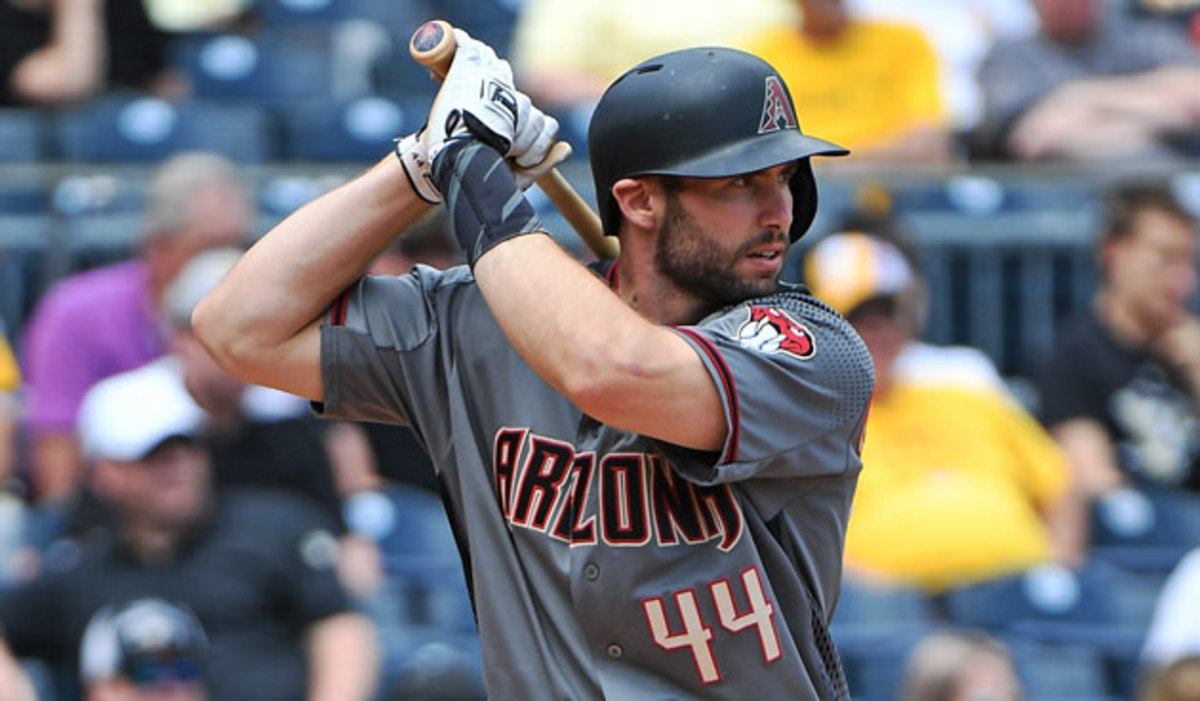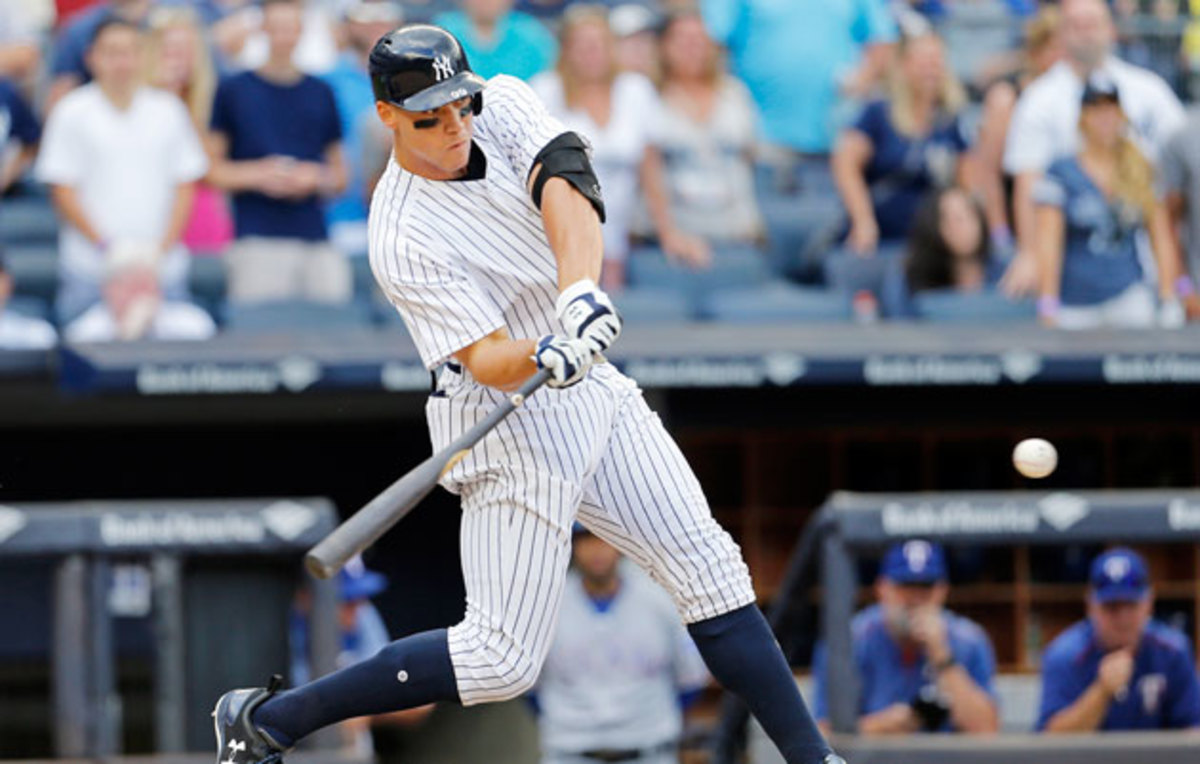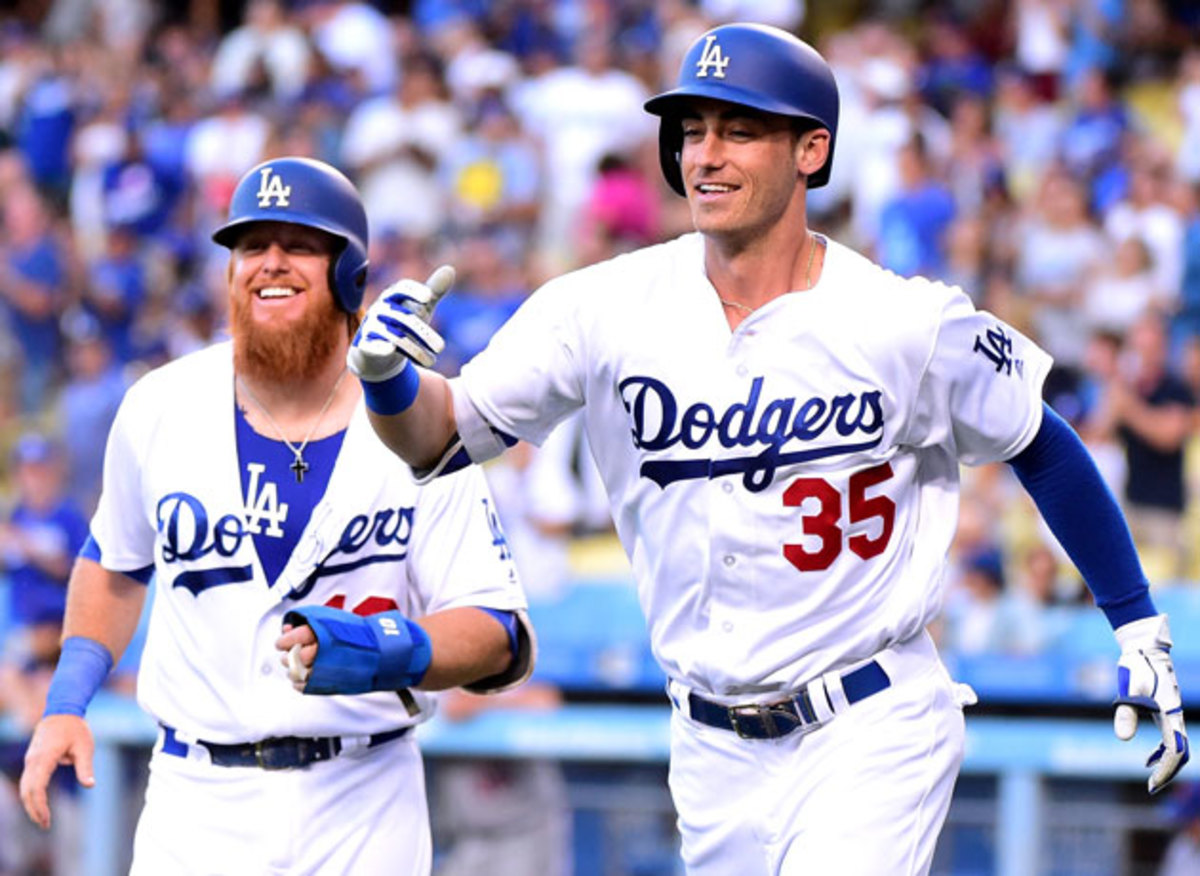Mid-Year Report: Aaron Judge shines, Cubs flail in homer-happy first half of 2017 season

It’s shaping up as a season for the record books: more strikeouts, more homers, more rookie sluggers, and perhaps more teams vying for playoff spots than ever before.
Strikeouts are up for a 12th straight year, reaching another record high. Home runs are flying out of ballparks like never before.
Oh, and games keep getting longer.
In other words, if you like action, the Tampa Bay Rays are your worst nightmare. No team takes longer to play an average game: three hours, 19 minutes. And much of their time is spent doing nothing. In a whopping 39% of their plate appearances—roughly two out of every five batters who steps to the plate—no defense or running is required because the play is not put in play. They are the kings of the Three True Outcomes (strikeouts, walks, home runs). And they are one of many American League teams still in the hunt for a playoff spot.
Halfway home, the American League is up for grabs as far as who can challenge the Astros. Washington and Los Angeles are the class of the National League.
All-Star Game rosters feature plenty of youth and even more power
It’s time to present the Mid-Year Report, a rundown on my picks for All-Stars at each position, the four major awards and the five biggest storylines of the season. (In picking my All-Stars, I don’t cop out and pick three “outfielders.” I picked the best at each unique outfield position, and considered the position where the player started the most games.)
Position | NL | AL |
|---|---|---|
C | Buster Posey, 30 | Salvador Perez, 27 |
1B | Paul Goldschmidt, 29 | Justin Smoak, 30 |
2B | Daniel Murphy, 32 | Jose Altuve, 27 |
SS | Corey Seager, 23 | Carlos Correa, 22 |
3B | Anthony Rendon, 27 | Jose Ramirez, 24 |
LF | Cody Bellinger, 21 | Justin Upton, 29 |
CF | Charlie Blackmon, 31 | George Springer, 27 |
RF | Bryce Harper, 24 | Aaron Judge, 25 |
DH |
| Corey Dickerson, 28 |
SP | Max Scherzer, 32 | Chris Sale, 28 |
RP | Kenley Jansen, 29 | Craig Kimbrel, 29 |
The skinny: Check it out: nobody over age 32. Sixteen of 21 in their 20s. Only three who switched teams as a free agent (Murphy, Scherzer, Upton). The lesson: better grow ‘em on your farm.

NL Awards
MVP
1. Paul Goldschmidt, Arizona
2. Bryce Harper, Washington
3. Charlie Blackmon, Colorado
4. Joey Votto, Cincinnati
5. Ryan Zimmerman, Washington
6. Corey Seager, Los Angeles
7. Justin Turner, Los Angeles
8. Anthony Rendon, Washington
9. Nolan Arenado, Colorado
10. Cody Bellinger, Los Angeles
The skinny: This one’s not even that close. Harper has been terrific, but Goldschmidt has been that good.
Oh, and by the way: First 861 career games: Goldschmidt .934 OPS, .301 batting average, 159 HR; Miguel Cabrera .924 OPS, .309 batting average, 170 HR. Get used to it, folks.
The 30: The Astros and Red Sox seize control of the American League while Yankees sputter
Cy Young
1. Max Scherzer, Washington
2. Clayton Kershaw, Los Angeles
3. Carlos Martinez, St. Louis
4. Zack Greinke, Arizona
5. Kenley Jansen, Los Angeles
The skinny: Scherzer leads in ERA, WHIP, innings and strikeouts. How’s that $210 million investment working out for Washington? With the Nationals, Scherzer is 44–24 with a 2.68 ERA. His ERA with Detroit had been 3.52.
Rookie of the Half Year
1. Cody Bellinger, Los Angeles
2. Kyle Freeland, Colorado
3. Josh Bell, Pittsburgh
The skinny: Bellinger changed his stroke in Class A to get the ball airborne. The result is the most whippy swing through a baseball since Jose Canseco. Upon follow-through, Bellinger regularly knocks himself in the back with the barrel of the bat.
Manager of the Half Year
1. Dusty Baker, Washington
2. Bud Black, Colorado
3. Torey Lovullo, Arizona
The skinny: Black was supposed to get the Washington job before the Nationals reversed field and gave it to Baker. Now the Nats and Rockies are the better for that decision. Baker brings his usual superb touch to a team that lost its centerfielder and leadoff hitter, Adam Eaton, has no reliable late-inning relievers, and now just lost its shortstop and replacement leadoff hitter, Trea Turner. Baker gets the most out of his stars.

AL Awards
MVP
1. Aaron Judge, New York
2. Carlos Correa, Houston
3. George Springer, Houston
4. Jose Altuve, Houston
5. Corey Dickerson, Tampa Bay
6. Mookie Betts, Boston
7. Mike Trout, Los Angeles
8. Jose Ramirez, Cleveland
9. Chris Sale, Boston
10. Justin Smoak, Toronto
The skinny: It’s difficult to remember any hitter who adjusted so quickly to plate discipline and bat-to-ball skills than Judge. A swing-and-miss machine last year has become the most compelling player in baseball. (He’s the new flavor). Try this on for size: Judge home runs by pitch type:
Pitch Type | Batting Average | Home Runs |
|---|---|---|
Cutters | .429 | 2 |
Curveballs | .379 | 4 |
Sinkers | .346 | 6 |
Changeups | .333 | 4 |
Four-seam fastball | .329 | 9 |
Sliders | .214 | 3 |
By the way, don’t think that sliders are his Achilles. Very few hitters hit sliders. It’s the most difficult pitch to hit in baseball. That’s why you see relief specialists predominantly throwing fastball/slider combinations. Nobody wants to bring sinkers and changeups out of the bullpen; they want the ball not to be put in play. The average big leaguer hits only .218 against the slider. Judge is just an average slider hitter, not a weak one.
Cy Young Award
1. Chris Sale, Boston
2. Lance McCullers, Houston
3. Jason Vargas, Kansas City
4. Yu Darvish, Texas
5. Craig Kimbrel, Boston
A shell of his Cy Young-winning self, what's the matter with Rick Porcello?
The skinny: Bill James likes to say a player new to Boston incurs a break-in tax; it takes a year to acclimate to the environment. Not Sale. His stuff is great, and the reason why it plays up even more is that nobody throws quite like him. Hitters have no frame of reference in their mental database.
Rookie of the Half Year
1. Aaron Judge, New York
2. Trey Mancini, Baltimore
3. Andrew Benintendi, Boston
The skinny: Mancini’s terrific season is being overshadowed by Judge. You might say the same about the season of lefthanded pitcher Jordan Montgomery, Judge’s teammate.
Manager of the Half Year
1. A.J. Hinch, Houston
2. Mike Scioscia, Los Angeles
3. Paul Molitor, Minnesota
The skinny: Hinch pushed for leadership and better quality at-bats. The Astros rid themselves of several stat darlings who gave too many empty at-bats. Now this team is running at full throttle with confidence, even with injuries to the rotation. Hinch’s use of super-reliever Chris Devenski has been genius.

The Biggest Storylines of the Half Year
1. The Great Home Run Surge.
The ball is livelier. Period. There is no way to explain the sudden (since the second half of 2015) and extreme jump in home runs without addressing the ball itself. My theory: the balls might have the same components, but they are manufactured better and tighter, falling within the lowest end of the allowable size and weight restrictions. (Most people don’t know official MLB balls are not one size; they have a leeway as much as a quarter of an ounce and a quarter of an inch in diameter.) Tighter baseballs with tighter seams have less drag. Less drag means more carry. More carry means more home runs. That’s what we’re seeing.
Yes, the Launch-Angle Revolution is inspiring more hitters to sell out for home runs. But here’s why that explanation only goes so far. According to baseballreference.com data, the percentage of balls in play that are flyballs has barely budged over the past four years (starting from 2014: 29.2, 26.8, 28.6, 29.8). We are not seeing a significant increase in flyballs. Yet the number of flyballs that are home runs has soared (7.7, 8.0, 10.3, 13.4).
Here’s what it means: if flyballs carried this year the same way they carried in 2014, and we had exactly the same number of flyballs, we would expect to see 2,873 of them go out of the park. Instead, we are on pace for 5,008 flyballs to leave the yard. That’s a 74% increase in flyballs that become homers. A surge that big just can’t be explained without bringing the ball into question.
One more piece of evidence that the ball is carrying farther: tape-measure home runs are becoming commonplace. We are on pace for 168 home runs measured by Statcast at 450 feet or more. That’s a stunning 38% increase just since 2015 (122).
2. Judge and Belly
We’ve never seen anything like this: two rookies, Judge and Bellinger, leading their league in home runs while on pace to hit more than 40. Oh, they also happen to play in the two largest markets on traditional powers in playoff position.
Only once in baseball history have two rookies hit 33 or more home runs: 1950, when Al Rosen hit 37 and Walt Dropo hit 34. Now Aaron Judge of the Yankees and Cody Bellinger of the Dodgers should smash their way well beyond those totals, while rookies Matt Davidson of the White Sox (17) and Hunter Renfroe of the Padres (16) are not far behind.
Logan Morrison isn't happy about MLB inviting Gary Sanchez to the Home Run Derby
3. The Cubs are bad.
Unless Kris Bryant gets voted in for the last roster spot, nobody from Chicago’s world championship team will be at the All-Star Game. (Trade acquisition Wade Davis is the team’s lone rep.) The Cubs reached the halfway point with a losing record (40–41). It’s not as if they’re been victims of bad luck or suddenly going to rip off a 20–3 run the way the Dodgers did. This team is going to struggle to get to the 87 wins it will take to win the mediocre NL Central. It has earned every bit of the poor record. Here’s why:
— Their older starting pitchers are showing the effects of getting pushed through the seventh month of competition last year.
Every one of them has lost miles per hour off their average fastball: Kyle Hendricks (down 2.37 mph), Jake Arrieta (-1.73 mph), Jon Lester (-1.31) and John Lackey (-1.13)—this in a year where changes in data collection actually added velocity for most pitchers.
— They miss Dexter Fowler.
The defense is significantly worse. Their other-worldly rates from last year have fallen, from first to seventh in defensive efficiency (down 31 percentage points) and from first to fifth in batting average on balls in play. Most of the decline on defense shows up in the outfield, where Kyle Schwarber was a liability in leftfield and John Jay and Jason Heyward can’t match Fowler in centerfield.
— They miss David Ross.
Willson Contreras is the greater talent, but he’s still learning how to catch and run a game. The Cubs’ walk rate has gone up 22% with Contreras behind the plate as compared to when Ross was back there last year.
Catcher | IP | BB% | K% | K/BB |
|---|---|---|---|---|
Ross (2016) | 448.2 | 7.9% | 24.9% | 3.14 |
Contreras (2017) | 502.2 | 9.6% | 23.4% | 2.46 |
The Cubs are walking a dangerous line: they are trying to win by putting a veteran pitching staff into an entirely young catching corps (Contreras and rookie Victor Caratini).
4. The Astros are the Best Team in Baseball
They are the most fun team to watch. The Astros also are state of the art.
Houston has built an aggressive, athletic offense that has learned the value of putting the ball in play in this era of strikeouts, and a pitching staff that relies on spin in this age of advanced measureables.
Here’s the cold, hard truth while everybody wants to obsess about increased velocity in the game: fastballs get hit.
Spin rates, not mph readings, are the way forward. Just two years ago not one team in baseball dared throw fewer than 50% fastballs. This year five teams are throwing fastballs less than half the time, and all five of them are competing for a playoff spot: the Indians (49.6%), Rays (49.1), Angels (48.7), Astros (47.5) and Yankees (an astoundingly low 43.2).
5. The Drought Watch (Continued)
In the past dozen years baseball ended the three longest World Series title droughts in history (Red Sox, White Sox, Cubs). This half season has kept alive the possibility of ending the fifth-longest drought ever (Indians) as well as six of the seven longest current droughts.
Take a look at this: the seven longest current World Series droughts, and where those teams stand at the halfway point.
Team | Years | Playoff Position |
|---|---|---|
Cleveland Indians | 68 | First place |
56 | 2 GB Wild Card | |
55 | First place | |
48 | First place | |
48 | First place | |
48 | 13 GB Wild Card | |
40 | 1.5 GB Wild Card |
Eight current franchises have never won the World Series: all the teams listed above except Cleveland, as well as the Rockies and Rays. Those eight title-starved teams have combined for 338 years of waiting. Now all of them except San Diego are still in the hunt for October.
